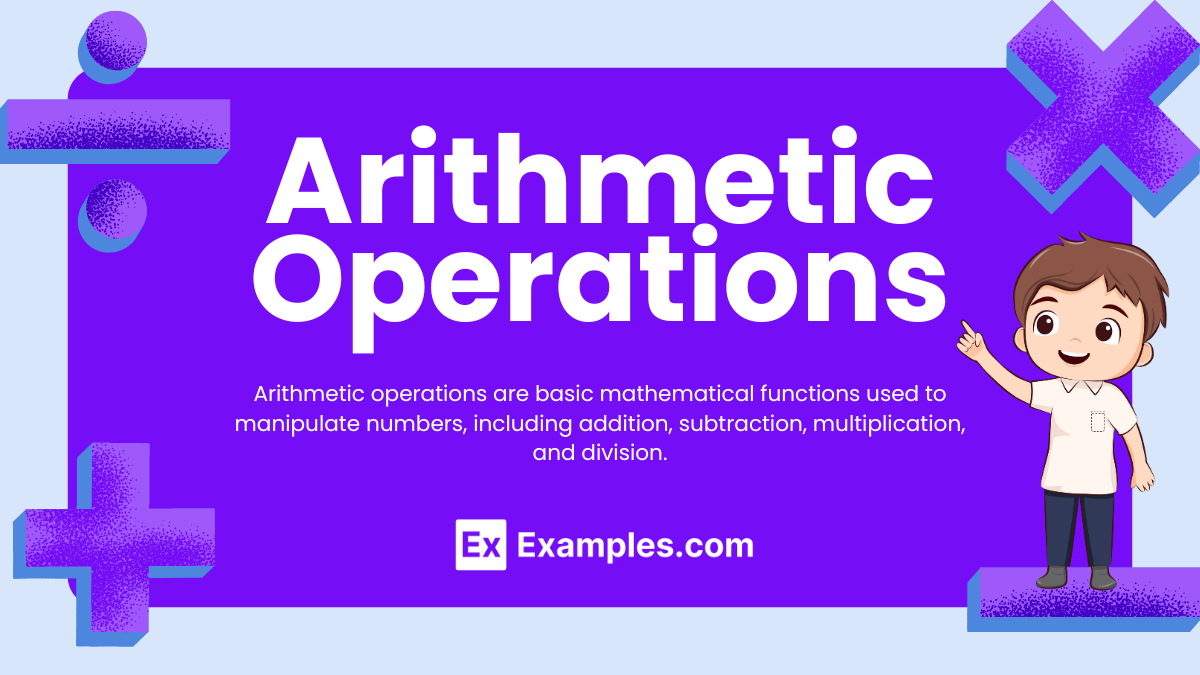What is the result of 12 + 7 × 2?
26
32
19
24

What is Arithmetic Operations?
Arithmetic operations are basic mathematical functions used to manipulate numbers, including addition, subtraction, multiplication, and division. These operations provide the foundation for more advanced mathematical concepts and are widely used in everyday scenarios and various fields.
| Operator | Symbol | Description |
|---|---|---|
| Addition | + | Combines two numbers or values to produce a sum. For example, 3+2=5 |
| Subtraction | − | Subtracts one number or value from another to produce a difference. For instance, 7−4=3 |
| Multiplication | × or ∗ | Multiplies two numbers or values to produce a product. For example, 4×3=12 |
| Division | / | Divides one number or value by another to produce a quotient. For example, 8/4=2. |
| Modulo | % | Computes the remainder after dividing one number by another. For example, 10%3=1. |
Addition is a basic arithmetic operation that combines two or more numbers or values to yield a sum. The operation is denoted by the symbol +. For instance, adding 3 and 4 gives 7, represented as 3+4=7. Addition is foundational in mathematics and everyday calculations.
Subtraction is an arithmetic operation that involves taking away one number from another to yield a difference. It is denoted by the symbol “-” (minus). For example, 7−3=4 shows how 3 is subtracted from 7 to produce
Multiplication is a basic arithmetic operation that combines two or more numbers or values to yield a product. It is denoted by the symbols ×× or ∗∗. For example, multiplying 4 by 3 gives 12, represented as 4×3=124×3=12.
Division is a basic arithmetic operation that splits a number into equal parts. It is denoted by the symbol // or a horizontal line. For example, dividing 10 by 2 yields a quotient of 5, represented as 10/2=5. Division is fundamental in mathematics and everyday calculations.
| Rule | Description | Example |
|---|---|---|
| Commutative Property | The order of addition or multiplication does not affect the result. | 𝐴+𝐵=𝐵+𝐴 and 𝐴×𝐵=𝐵×𝐴 |
| Associative Property | The grouping order of addition or multiplication does not affect the result. | (𝐴+𝐵)+𝐶=𝐴+(𝐵+𝐶) and (𝐴×𝐵)×𝐶=𝐴×(𝐵×𝐶) |
| Identity Property | Addition and multiplication have identity elements: 0 and 1, respectively. | 𝐴+0=𝐴 and 𝐴×1=𝐴 |
| Distributive Property | Multiplication distributes over addition. | 𝐴×(𝐵+𝐶)=𝐴×𝐵+𝐴×𝐶 |
| Additive Inverse Property | Every number 𝐴 has an additive inverse −𝐴 such that their sum is zero. | 𝐴+(−𝐴)=0 |
| Multiplicative Inverse Property | Every non-zero number 𝐴 has a multiplicative inverse 1/𝐴 such that their product is one. | 𝐴×(1/𝐴)=1 (if 𝐴≠0) |
If 𝐴=7 and 𝐵=3, calculate the following:
Consider three numbers 𝐴=5, 𝐵=4, and 𝐶=3. Solve the following:
Given two integers 𝐴=12 and 𝐵=8, find:
Simplify the expression 𝐴⋅(𝐵+𝐶) for 𝐴=2A=2, 𝐵=3B=3, and 𝐶=5C=5.
First, evaluate the addition inside the parentheses: 𝐵+𝐶=3+5=8
Next, multiply by 𝐴⋅(𝐵+𝐶)=2⋅8=16
The four basic arithmetic operations are:
The five key arithmetic operators are:
The six key mathematical operations include:
The basic rules of arithmetic include:
The golden rule for solving equations is to maintain balance on both sides of the equation. Any operation performed on one side must be mirrored on the other. This ensures the equation remains valid and allows for correct solutions.
An example of an arithmetic operation is:
3+5=83+5=8
Here, two numbers are combined through addition to yield a sum. This demonstrates a simple yet fundamental operation used in arithmetic, applicable in various contexts.
The correct order of arithmetic operations is:
This order is often remembered by the acronym PEMDAS.
Multiplication and division are of equal precedence in arithmetic. When evaluating an expression, you process these operations from left to right, performing whichever one appears first in the order of the expression
Text prompt
Add Tone
10 Examples of Public speaking
20 Examples of Gas lighting
What is the result of 12 + 7 × 2?
26
32
19
24
If you subtract 15 from 40 and then divide the result by 5, what do you get?
5
7
9
12
Calculate 6 × (3 + 2).
18
30
34
38
What is 56 ÷ 8 + 9?
18
20
25
15
Find the result of 8 × (4 − 1).
24
18
32
22
If 5 × 6 − 7, what is the result?
28
30
35
23
Evaluate (9 − 4) × 3.
12
15
18
20
What is the result of 14 + 12 ÷ 4?
17
19
22
26
Calculate 24 ÷ (3 + 1).
6
8
12
10
What is 45 − 8 × 3?
21
29
30
15
Before you leave, take our quick quiz to enhance your learning!

